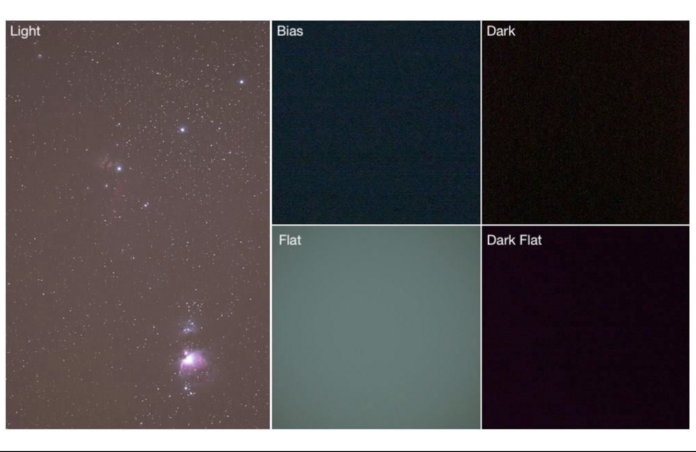a short primer on calibration frames

After I posted a column on image sensor amp glow, or just what’s called glow, there were a few questions around calibration frames. So, this week I’ll try to provide a short primer on calibration frames to help provide some understanding on what they are, how they’re used and how they’re taken.
When you take your deep sky astro images, they contain not just image data on the target you selected to image that you wanted to get a lot of, but also a lot of unwanted data that you would prefer to not have. This additional unwanted image data is generally in the form of noise of all types, amp glow, dust, vignetting and artifacts and other imperfections that will negatively affect the quality of your final image. We use calibration frames to correct for these problems so that our final image is as good as we can make it. There are 4 types of calibration frames: Darks, Flats, Bias and Dark Flats.
Dark frames are used to correct for hot pixels on the sensor and sensor heat noise, including amp glow from the sensor. These problems will show up in your images if they’re not accounted for and processed for removal. Dark frames are very easy to acquire; you must match the sensor temperature, gain, offset and exposure time that you took your light frames at, then simply cover the telescope aperture completely and take roughly 30 to 50 sub exposures. Later, you stack and integrate these sub exposures into a single master dark file that you will use to calibrate your light frames. You can create a library of these types of sub exposures, using different exposures times and sensor temperatures to use on later projects but you should retake dark frames and refurbish your dark library about every 3 to 4 months. The reason is that hot pixels on the sensor can change over time; the darks you used previously may not be accurate with where hot pixels are now. If you calibrate your light frames with old dark frame data, you could wind up with artifacts.
Bias frames are very similar to dark frames, except that the length of exposure you use to acquire them is as short as your imaging camera is able to take them. Bias frames are used to calibrate out the sensor camera’s readout noise. As electricity flows through your camera to take the image, there is signal noise from the electricity used to do this. The requirements to take bias frames are the same as taking dark frames except that the exposure time is usually 0.1 seconds or less. Again, 30 to 50 of these kinds of sub exposures should be taken, stacked and integrated into a master bias file.
Flat frames are the calibration frames that keep us up at night. These are used to address vignetting, dust and other particles that get in all parts of the imaging train, such as focal reduces, coma correctors, field flattners and of course the image sensor itself. What this also means is that for these calibration frames to be effective, you must not break the image train between the time you take the image light frames and the flat calibration frames for these light frames.
You should take these frames as soon as possible after you take the light frames. Also, be careful you do not bump or disturb the image train before you shoot the flats. Doing so could disturb the dust or particles just enough so that the flat frames you take won’t be correct for your light frames anymore.
To take flat frames, you will need to use an evenly illuminated light source. This is done either with an artificial light source or in the morning using indirect sunlight with a T-shirt covering the telescope aperture. This is one of the reasons flat calibration frames are not easy to properly capture. As with darks and bias frames, you need to use the same temperature and gain / offset or ISO as your light frames. You also need to set a median ADV value of around 32,000 or the midpoint of the camera’s histogram. Meeting this condition and the level of light illumination will determine the exposure time you will need to use. Additionally, if you use a monochrome camera with filters, you will need flat frames completed with each filter that you used to image the target. For one shot color cameras, you only need one set of flat frames for this. Again, you should shoot 30 to 50 sub exposures for each set of flat frames.
Some image sensors, especially CMOS sensors have problems with very short exposure times. For these devices, bias frames will not be usable and generally will make things worse instead of better. Flat Dark frames are the calibration frames used instead. These are just flat frames taken with the cover over the aperture as you would do to take with dark frames but set at the same exposure times that you used to take your flat frames. The same rules apply for flat darks.
Stay safe and get your neighbors to turn off their lights at night….
This blog post was originally published in our Telescope Live Community.
The Community represents Telescope Live's virtual living room, where people exchange ideas and questions around astrophotography and astronomy.
Join the conversation now to find out more about astrophotography and to improve your observation and post-processing skills!
